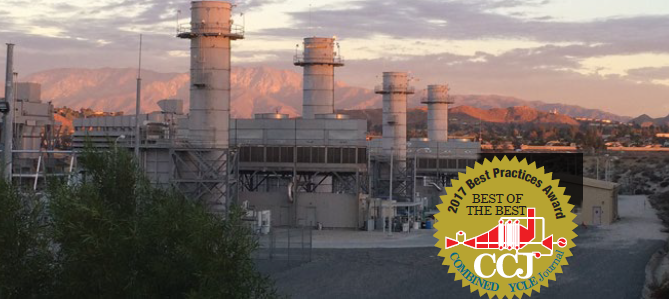Plant staff fine-tunes operations, implements mods, upgrades to reduce startup NOx

These are difficult times for owner/operators of conventional assets. They get no relief from regulatory bodies regarding emissions, grid operators aren’t bashful about making still more demands on them, profit margins and O&M budgets have been squeezed dry in many cases, OEM solutions can be too costly, etc.
What to do? One thing is to “improvise, adapt, and overcome” the challenges facing your plant with in-house talent. Take a page from the lesson book of Riverside Public Utilities, the only aero facility recognized in 2017 with a Best of the Best award in the CCJ Best Practices Program.
The Riverside Energy Resource Center consists of four LM6000 simple-cycle peakers used to supply 200 MW of reliable fast-start power to the 105,000 electric customers served by the municipal utility. Each gas turbine satisfies its NOx emissions permit with water injection and a selective catalytic reduction system using 19% aqueous ammonia.
In addition to Riverside’s commitment to its city customers, the California Independent System Operator (CAISO) demands the four gas turbines be available for state-required dispatch when not used for self-generation. The CAISO frequent calls for the engines to start up, sometimes multiple times daily. The problem faced by the asset owner: Each start produces three times the amount of NOx as does a normal production hour.
The Riverside facility is located in the most environmentally challenged air district in the nation—the South Coast Air Quality Management District. It restricts monthly and annual operations based on pounds of NOx discharged. Given the frequent starts mandated by the CAISO, the South Coast AQMD in effect reduces the number of hours the Riverside units can run monthly and annually. But the CAISO and the city of Riverside need the power “on demand” 24/7/365.
The utility found itself between the proverbial “rock and a hard place.” It could re-permit and purchase emissions offsets at prohibitive cost in both time and money, or find a way to reduce startup NOx emissions. The latter was the path chosen and it proved a career test for the solutions team headed by Generation Manager Chuck Casey, Plant Manager Bryan Atkisson, and technicians James Mysliwiec, Will Patton, and Ron Herrero.
One of the first steps was to see what the OEM could offer. The team re-learned that the turbine manufacturer would not deviate from tried and true historical methods of equipment operation and was more interested in selling new systems than in upgrading old ones.
The team moved forward by creating a wish list of possible changes to reduce NOx mass emissions. They termed this effort “black box” considerations because many of the proposed solutions were visionary—not yet available—but seemed achievable. Equipment suppliers were dared to go beyond their safety nets—to loosen limits without damaging equipment or causing emissions upsets. Staff worked closely with equipment and operations partners to seek feasible results.
Success! After two years of researching, teaching, challenging, experimenting, brainstorming, and implementation, a 30% reduction in startup NOx was achieved, allowing a commensurate increase in operating hours while still holding emissions within the South Coast limits. Specifically, the number of starts was increased from 40 to 62 per month.
The path chosen to achieve a 30% reduction in startup NOx involved the following:
- Use of a megawatt feed-forward signal to control ammonia flow rather than fuel flow, which is a lagging indicator.
- Tune/improve the water injection curve. Keep in mind that water does not harm the SCR catalyst.
- Lower the NH3 control valve/SCR temperature interlock set point.
- Reprogram the ammonia vaporization heater. The SCR/NH3 injection temperature was reduced to 350F from about 540F to start the SCR earlier.
- Improved maintenance.
The NOx mass emissions reduction program achieves the equivalent of investing $2 million in emissions offsets while increasing operational flexibility without exceeding local, state, and federal limits. The Riverside team believes it has learned enough to aim for a higher target by year-end—a 40% reduction in startup NOx mass emissions. CCJ



